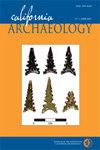Beyond Ethnography and Beneath the Bedrock Mortars: The Eastern Transverse Ranges of Southern California as Early Holocene Refugia
IF 0.7
0 ARCHAEOLOGY
引用次数: 0
Abstract
ABSTRACT Rock Camp (CA-SBR-342) in the San Bernardino Mountains has been regarded as a seasonal Late Prehistoric Complex acorn processing base camp since it was excavated in the 1960s. Reanalysis of its collections and new investigations at the nearby Willow Creek Crossing sites permit reevaluation of archaeological models for the Transverse Ranges of southern California and the adjacent Mojave Desert. Diagnostic artifacts, site structure, and obsidian hydration dating indicate montane Greven Knoll I (9,400-4,000 BP) occupations in inland southern California several millennia earlier than has been previously posited. Moreover, the presence of stemmed points suggests that the Greven Knoll Pattern of the Encinitas Tradition was introduced into the region directly from the Mojave Desert during the onset of the Altithermal. This analysis also serves as a reminder for archaeologists to use ethnohistoric models with caution and to look beyond the obvious.超越人种学和基岩之下:作为全新世早期避难所的南加州东部横向山脉
摘要圣贝纳迪诺山脉的岩石营地(CA-SBR-342)自20世纪60年代被发掘以来,一直被视为一个季节性的晚史前综合体橡子加工大本营。通过对其藏品的重新分析和对附近Willow Creek Crossing遗址的新调查,可以重新评估南加州横向山脉和邻近莫哈韦沙漠的考古模型。诊断性人工制品、遗址结构和黑曜石水合年代测定表明,加利福尼亚州南部内陆的山地Greven Knoll I(9400-4000 BP)职业比之前推测的要早几千年。此外,茎点的存在表明,恩西尼塔斯传统的Greven Knoll图案是在Altitherma爆发期间直接从莫哈韦沙漠引入该地区的。这一分析也提醒考古学家谨慎使用民族历史模型,并超越显而易见的事实。
本文章由计算机程序翻译,如有差异,请以英文原文为准。
求助全文
约1分钟内获得全文
求助全文

 求助内容:
求助内容: 应助结果提醒方式:
应助结果提醒方式:


